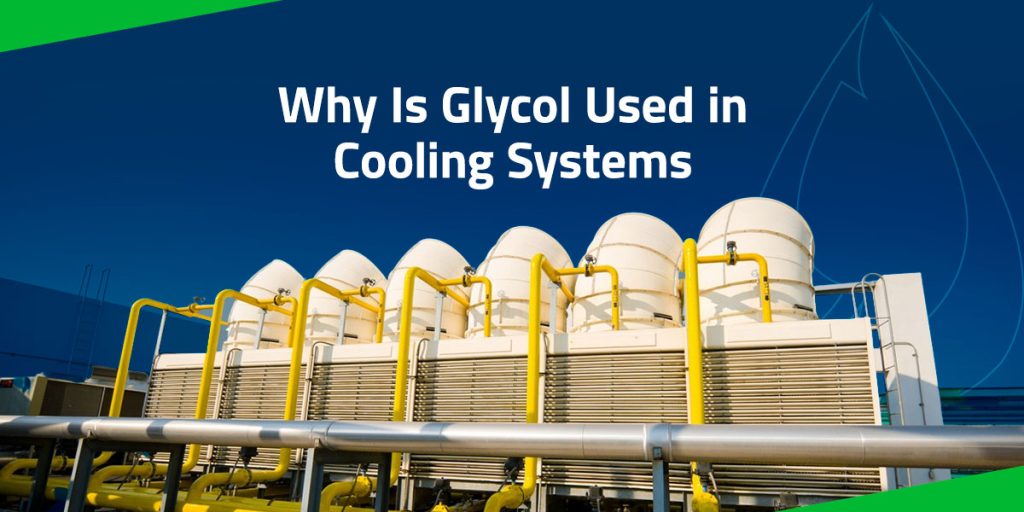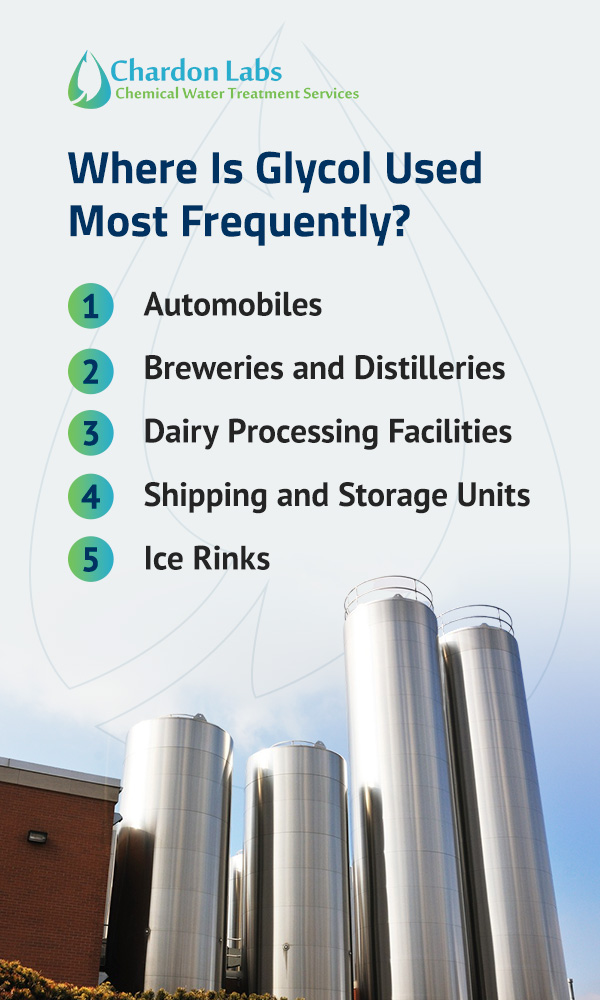
Glycol is a viscous, colorless and odorless synthetic liquid. It’s a common antifreeze ingredient for mechanical cooling systems and automotive engines. It can absorb and release large amounts of heat while maintaining a consistent temperature. This unique ability makes it suitable for beverage chillers and other industrial refrigeration applications.
There are two main types of glycol:
Glycol is an asset for HVAC cooling systems, primarily due to the way it reacts with water. It can help keep pipes from freezing in frigid temperatures. Water has a freezing point of 32 degrees Fahrenheit. The addition of glycol can lower water’s freezing point by as much as minus 60 degrees Fahrenheit.
Thanks to glycol, cooling systems can maintain colder temperatures than they could with only water. That’s why glycol cooling systems are a popular solution in food processing facilities, manufacturing plants and other industrial settings. Learn more about how glycol benefits cooling systems.
Glycol was a game-changer for various applications due to its versatility. It allows manufacturers to customize coolants for numerous uses. Let’s explore the origins of glycol and its impressive cooling properties below.
Up until the early 20th century, alcohol was the standard ingredient for automotive antifreeze. These antifreeze products were typically made of methanol, also known as wood alcohol. Alcohol has a lower freezing point than water, making it the antifreeze of choice back then.
However, alcohol can spell trouble for metal engine components, causing extreme corrosion and rust. Early water cooling systems were also open, allowing the alcohol to evaporate gradually. If operators didn’t constantly top up their systems, the coolant could freeze or the engine could overheat.
In response to this issue, glycerol was introduced as an antifreeze in the early 1900s. But it was expensive to produce, and eventually ethylene glycol was its replacement.
French chemist Charles-Adolphe Wurtz first produced ethylene glycol in 1859, making it one of the oldest antifreeze solutions. However, it wasn’t commercialized until 1918. It was manufactured on a small scale during World War I, serving as both a coolant and an ingredient for explosives.
Ethylene glycol became available as an automotive antifreeze in 1926, and its military use continued into World War II. To prevent damage to metal vehicle components, manufacturers added corrosion inhibitors to the ethylene oxide and water mixture.
Corrosion inhibitors help the liquid coolant remain alkaline (having a pH above 7). However, acidity naturally increases over time, so coolant must be changed regularly to avert corrosion.
When ethylene oxide became cheaply available, widespread ethylene glycol manufacturing began in 1937. Its large-scale production sparked a minor revolution in aircraft engineering. When manufacturers substituted ethylene glycol for water as an engine coolant, they discovered its high boiling point enabled smaller radiator operation at higher temperatures.
Before ethylene glycol’s widespread availability, aircraft manufacturers tried using evaporative cooling systems that used water at high pressure. These systems were unreliable and highly susceptible to damage during combat. They occupied substantial space on planes, making them easy targets for gunfire.
Ethylene glycol has a boiling point of 386 degrees Fahrenheit and a freezing point of 10 degrees Fahrenheit. Due to these characteristics, manufacturers found it had a broad array of industrial uses. Ethylene glycol on its own doesn’t conduct heat as efficiently as water. When combined with water, however, its heat transfer and functional range expanded significantly. Besides providing exceptional heat transfer, ethylene glycol can also suppress algae growth in heat transfer equipment.
Wurtz also produced propylene glycol in 1859, but the substance wasn’t commercialized until 1931. While propylene glycol can’t rival the heat transfer of its ethylene counterpart, it is also less toxic. This attribute makes it ideal as a solvent in food, cosmetic and pharmaceutical products.
Propylene glycol’s main drawback is that it’s often made from petroleum, a nonrenewable resource. Over 1 million tons of petroleum are needed to meet worldwide demand annually. In 2001, two American chemical engineers from the University of Wisconsin-Madison — James Dumesic and Rady Cortright — created a process that converted corn-based lactic acid to propylene glycol. This process omitted the need for petroleum-based chemicals, lowering the cost to manufacture propylene glycol.
Today, propylene glycol has a multitude of uses, acting as a preservative, stabilizer, freeze point modifier and wetting agent.

Glycol coolers serve an extensive range of industries, from automotive to brewing. They offer outstanding performance in low-temperature environments, like ice rinks and food processing facilities. Here are some of glycol’s common cooling applications.
Glycol is an excellent antifreeze for automobiles and industrial water systems. It can also serve as a de-icing fluid for aircraft and windshields because of its low freezing point.
The brewing and distilling industry relies on glycol chillers, as it requires consistent and controlled temperatures. Any fluctuations can negatively impact the final product quality. Propylene glycol chillers help maintain and regulate container temperatures, making them a must for:
Dairy products require a proficient cooling system to prevent bacterial growth. Milk is pumped from cows into cooling units, which store the milk until processing. Each stage of this process requires precise temperature control. The raw milk must maintain a consistent temperature to prevent bacteria and spoilage.
Grocery stores must maintain consistent temperatures in cooling units to prevent spoilage. Likewise, fruits, vegetables and other perishables must remain fresh during packing and shipping. Propylene glycol chillers are essential to meet produce packaging, shipping and storage requirements.
Because glycol chillers can achieve a lower freezing point than water, they can be installed in outdoor ice rinks, even in warmer climates. Mats are typically placed beneath the rink’s surface and pumped with glycol. Water is then sprayed over the mats and freezes.
How do glycol chillers help maintain cool temperatures in closed loop systems? Here are the different steps that must take place.
The first step is installing a glycol chiller — a refrigeration system that cools a tub of glycol — in a closed loop water system. The glycol moves through a closed piping or tubing circuit that connects to the chiller. This process helps reduce the glycol temperature of whatever is hooked up to the system.
Heat exchangers must be attached to the closed loop system’s input and output to achieve efficient cooling. Different cooling systems use different types of heat exchangers, such as:
The heat exchangers should connect to the main cooling line that circulates the water and glycol mixture.
The glycol cools the vessels as it circulates through the heat exchanger, successfully cooling the vessel. A closed loop’s cooling system can vary depending on its configuration and your operations. A knowledgeable water treatment provider can work with you to install a safe, efficient glycol cooling system in your facility.
A glycol chiller’s powerful antifreeze properties can provide consistent, reliable performance in various operations. When considering the benefits of a glycol chiller, this cooling system has the upper hand over conventional ice- and water-based industrial cooling processes. Here are some advantages glycol cooling can bring to your facility.
Glycol can accommodate even the tightest temperature ranges. Unlike traditional refrigeration systems — which use direct expansion evaporators — glycol systems generally use flooded evaporator coils. These coils provide higher temper holding times, quicker temperature pull downtimes and improved recovery times after defrosting.
In turn, glycol cooling helps yield fresher and higher-quality products, reduces wastage and boosts product shelf life. With frozen and refrigerated foods, for instance, glycol cooling offers consistent temperatures that prevent bacteria, rotting and spoilage. It ensures fresher, better-tasting products.
Glycol helps inhibit bacterial growth and corrosion in a closed loop system’s pipes. These contaminants can produce high levels of metal oxides, leading to fouling (degraded heat transfer) and other issues. These problems can lead to failure and costly repairs.
Overheating can also cause equipment to malfunction or break down, raising repair costs and setting back operations significantly. A glycol chiller helps protect equipment from microbiological growth, corrosion and heat-related damage.
Additionally, glycol cooling systems typically encounter fewer refrigerant leaks due to increased efficiency throughout the unit. Glycol cooling also saves money by reducing the volume of refrigerant in the system.
Glycol is a biodegradable refrigerant, making it an environmentally friendly option for closed loop cooling applications. Additionally, glycol chillers have multiple energy-efficient options, such as:
Glycol chillers can become clogged with dirt and sludge over time. Additionally, your glycol system’s pipes can start to corrode due to acidity, as well as particles or solids introduced when the system was last worked on. Cleaning a glycol system is important to maintain peak performance and longevity. Here are some tips for cleaning your glycol system to keep it free of foreign matter.
Turn off the chiller, then use a hose to rinse the coils gently from the outside. Rinsing helps remove dirt, dust and other debris that may have accumulated on the coil.
Remember to clean the area around the chiller, as well. This helps ensure any rinsed-off debris doesn’t get sucked back into the condenser later on. If the condenser is exceptionally dirty, many hardware stores have special coil cleaners. Follow the package’s directions to ensure you’re using it correctly.
Wipe down the inside of the chiller and look for oil residue. Should you spot any, there may be a refrigerant leak. Be sure to contact a service technician right away to address this issue.
Glycol breaks down over time, rendering the metal more vulnerable to corrosion. Closed loop water requires ongoing chemical treatment, even if the glycol has an inhibitor.
An experienced water treatment provider can help you select and apply treatment chemicals based on your system’s needs. Chemicals limit or remove harmful corrosion deposits. This process improves heat transfer and allows the liquid to flow more smoothly through the pipes. A water treatment expert can also help you flush the pipes after chemical treatment.
If you’re looking to install a glycol system for your closed loop — or you require maintenance on an existing setup — it’s best to consult a company with decades of industry expertise.
At Chardon Laboratories, we provide a variety of closed loop water treatment services. We use ethylene glycol in most of our closed loop applications. While propylene glycol is less toxic and more eco-friendly, it doesn’t achieve the same freezing point and cooling abilities as ethylene.
Our ISO-certified technicians perform comprehensive closed loop maintenance, preventing leaks and other costly issues. We can help you create a customized water treatment plan based on your unique requirements and operations. This plan includes:
Let Chardon Labs help your closed loop system achieve peak performance, efficiency and longevity. Contact us today and learn more about our closed loop water treatment services!